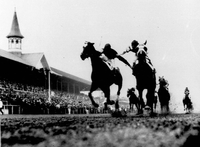Evaluate and place these aged Quarter-type geldings in your order of preference. Then see how your choices compare to our expert judge's.
 |
I consider four criteria when evaluating conformation: balance, structural correctness, quality/breed characteristics and muscling. I look for a horse that's the best combination of all four.
To assess balance, I first look to see if a horse's body ties together smoothly and proportionately. Then I mentally divide him into three sections: 1) from point of shoulder to heartgirth (behind the horse's shoulder); 2) from the heartgirth to the point of hip; and 3) from the point of hip to the tailhead. Ideally, these lengths will be equal.
I want a horse's neck to be long and lean, and I want him to have an equally sloped shoulder and hip. I also want him to have a level back, and for his withers and croup to be the same height. Structurally, he should exhibit upright, correctly aligned leg bones, and hocks with neither too little, nor too much angle.
For quality/breed characteristics, a horse's head should be short (from poll to muzzle) and proportionate, tapering at the muzzle for a chiseled appearance. His eyes should be large with a kind expression. He should also show his breed's ideal characteristics.
Then I evaluate muscling on volume (muscle amount), length (how far it extends to its connection point) and definition (tone and conditioning).
Click "Next" to find out how I placed these aged Quarter-type geldings.
First: Gelding C This horse is also more structurally correct, especially down both front and hind legs, viewed from the side. Leg structure is the foundation for support and soundness. Viewing leg structure from the front and rear, I look for straight alignment--from point of attachment down through knee and hock, through the cannon bones, pasterns and toes. From the side, I look for a front leg with adequate angle in the arm (as it comes out of the shoulder), and extends down a straight column of bone. For cushion, shock absorption and stride, I like to see a 30- to 45-degree angle in pasterns (hopefully about the same as the shoulder angle). The hock should be properly placed so the cannon is upright and there's a correct angle in both the stifle and the hock--that'll allow for proper motion of the hind leg and a stride underneath the body. This horse also has an overall smooth blending appearance that reflects his balance. And good balance contributes to performance capabilities. He has a desirable shape to his head, which reflects adequate quality and breed characteristics, and he has an acceptable topline which contributes to his overall balance. Ideally he could be cleaner in his throatlatch, and I'd like to see him heavier muscled.
Second: Gelding B He's also somewhat trimmer in his throatlatch and neck. While neither horse ties in as high at the base of their neck as I like to see, the second place horse appears more correct down his front leg. Ideally, this horse would have a more refined head, his neck would tie in higher at the base of the neck, and he'd be straighter down his hocks when viewed from the side.
Third: Gelding A The two clear advantages this horse has over the second place horse is that again, he has a more attractive head, which tapers down his face to a more refined muzzle; and he's straighter down his hock from the side than the second place horse. John Pipkin, Ph.D., holds judges cards for the American Quarter Horse Association, American Paint Horse Association, National Reining Horse Association, National Reined Cow Horse Association, and National Snaffle Bit Association. He's judged nearly 300 shows nationally and internationally, including the AQHA Youth World Championship Show (twice), the APHA World Show, AQHA Amateur World Show (twice) and the APHA Youth World Show. Aside from judging, John is a professor at West Texas A&M University. This article originally appeared in the March 2007 issue of Horse & Rider magazine. Enter Your Horse in Conformation Clinic! To submit a photo of your horse to be evaluated in Horse & Rider's Conformation Clinic, send us a left-side view photo of your horse (for digital phots: high-resolution, 300 dpi, in at least 3" x 5"). Make sure he's well-groomed, looking straight ahead and standing on level ground--and try to avoid distracting backgrounds. Email amanda.peterson@equinetwork.com and include your contact info and your horse's breed, age, gender and height. |
| Find this article at: http://www.equisearch.com/horses_care/health/anatomy/quartertypeconf_030107/index1.aspx |
Trackback URL : 이 글에는 트랙백을 보낼 수 없습니다
Trackback RSS : http://www.fallight.com/rss/trackback/1340
Trackback ATOM : http://www.fallight.com/atom/trackback/1340










